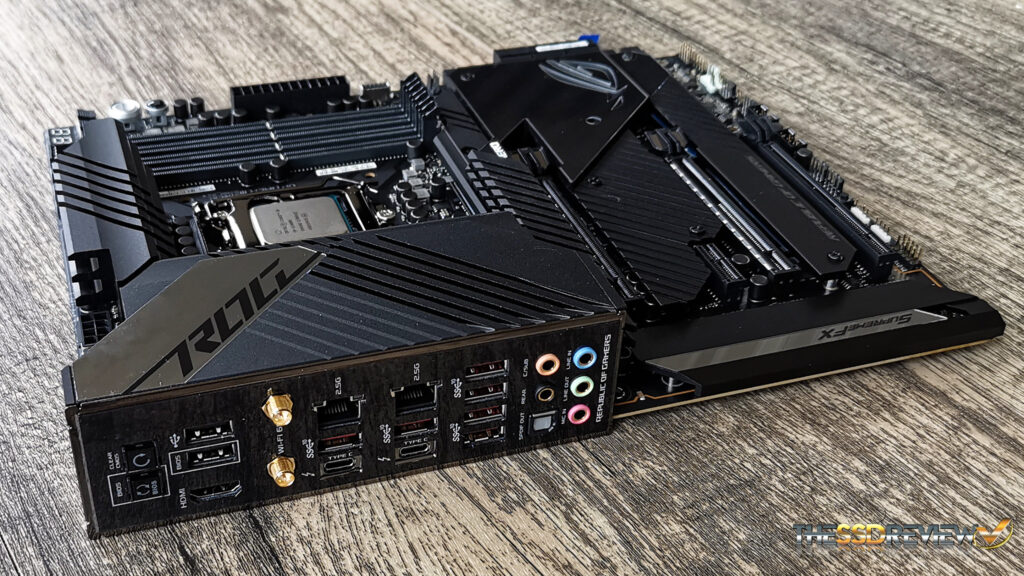ASUS ROG MAXIMUS XIII HERO Z590 MOTHERBOARD
We are always looking for a motherboard that has it all…the complete package. Traditionally, you could get ThunderBolt 3 or you could get USB 3.2 Gen 2. There are never enough lanes (ain’t that a fact) and why they include so many SATA ports as well as the long extinct PS2 port is totally beyond me. USB ports… Why the heck are there multiple speed USB ports rather than simply including the latest and greatest. Anyway… This new ASUS ROG Maximus Z590 Hero Gen 4 motherboard changes most of that with some great features!
First off, we have two Thunderbolt 4 ports on the back panel, as well as a USB 3.2 Gen 2×2 header for the chassis and we can confirm that we get 2.8GB/s data transfer from the two Tbt3 ports and 1.8GB/s data transfer from the USB 3.2 Gen 2×2 port on our Corsair 5000x chassis. This is beautiful.
The ASUS Rog Maximus XIII Hero Z590 supports 10th and 11th Gen Intel Core Processors, has 2 x PCIe 4.0 x16 Safeslots from the CPU and 1 x PCIe 3.0 x16 Safeslot from the 500 series chipset. It has four M.2 slots, the top two dedicated to PCIe 4 from the CPU and the bottom two are PCIe 3.0 from the chipset, along with another PCIe 3 x1 slot from the chipset. This board supports up to DDR4 5333MhZ+ OC memory, has 14+2 Power Stages, supports NVIDIA 2-way SLI Technology, and uses a SupremeFX ALC404082 HD audio codec with an ESS Sabre9018Q2C DAC.
There are six SATA 3 connectors and we can see the metal header for the chassis contained USB 3.2 Gen 2 20Gbps port along with the two USB 3.2 Gen 1 connectors. Now… Something to think about. The Z590 hero has 20 PCIe 4.0 lanes and you need to position things carefully as the 500 series chipset uses only PCIe 3.0. This means that your bottom two M.2 slots are PCIe 3.0 and we wish ASUS would have encorporated PCIe 4 into the chipset but understand that this may have bumped the price of the board significantly.
You can easily install a Gen 4 SSD and PCIe 4.0 x16graphics card if that’s all you have but that fills up your 20 CPU lanes (16×4). On the Hero, if you want to use your M.2_2 slot which is via the CPU, your lanes get split automatically between the first two PCIe 4 x16 slots and that M.2 slot. Simply, two cards drop to X8 or a single card with a SSD in that second slot drops to x8 and x4.
If you have read our previous reports, you will also know that we avoid motherboards that have no way of indicating problems or issues with installation. We have always favored ASROCK for their Dr. Debug LED and much is the same with the new ASUS ROG Hero. Not only does it have an LED top right for Q-Codes with a Start and ‘Flex key’ below that, but also, there is a BIOS reset and Clear CMOS button on the back panel. The bonus here is that the ;Flex Key’ button can be configured to any number of functions, and as well, the LED can be shut off on successful post, remain on or display the CPU temperature.
Last but not least, we have the ASUS Hero Z490 backplate which contains the BIOS Flashback and Clear CMOS Buttons, HDMI 2.0 port, and two USB 3.0 ports. Below that we have the dual antennas for the onboard Onboard WiFi 6E (802.11ax), dual Thunderbolt 4 Type-A ports, with dual USB 3.2 Gen 2 10Gbps Type-A port and then dual Intel 2.5G ethernet ports. Below that we have another four USB 3.2 Gen 2 Type-A ports, SPIDF out and audio ports.
Checking Amazon, we are seeing the ASUS ROG Maximus XIII Hero Z590 motherboard at a price of $499US which is a great price in consideration of the fact that this board is one of the most feature rich boards available.
 The SSD Review The Worlds Dedicated SSD Education and Review Resource |
The SSD Review The Worlds Dedicated SSD Education and Review Resource | 


It’s not just ASUS, every Z590 comes with PCIe 3 lanes coming from the chipset, incidentally this is a huge step back in terms of storage compared to the X570.